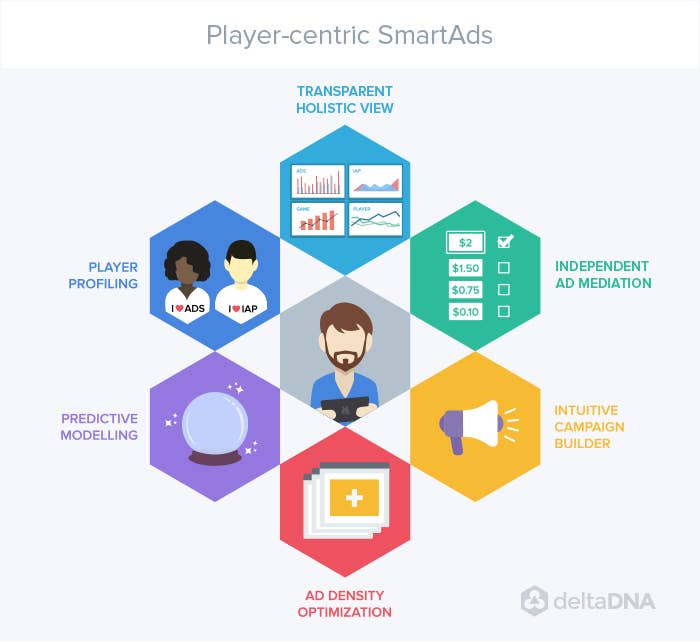How intelligent in-game ads can change free-to-play
Merely including in-game ads isn't enough; they need to be presented in a way that keeps both users and advertisers happy
With free-to-play dominating both the most-played charts and rueful post-mortems of underperforming premium titles, developers and publishers are rushing to embrace the model. But as with all gold rushes the later arrivals are finding it much harder going than the pioneers. Competition is fierce and getting fiercer, and even if your game is able to get its moment on the storefront it can be a struggle to effectively monetize once it's installed. Merely including in-game ads isn't enough; they need to be presented in a way that keeps both users and advertisers happy.

Winning users over
"Ads, when integrated appropriately, have become a great way to earn incremental revenue alongside in-app purchases," says Shannon Chang, Senior Marketing Manager at Superpower Studio. For others, ads are the primary means of monetization. "For the majority of free-to-play games most players will never pay for in-app purchases," according to a senior marketing manager at a major games publisher.
"Ads help developers monetize and sometimes, in the case of rewarded ads, convert," they continued, "but there's a stigma associated with them, in part due to some aggressive integrations that interrupt gameplay and degrade the user experience." The trick, says Chang, is, "figuring out the right moment to engage our players with ads, and the appropriate number of ads to show each player, without inhibiting the user experience."
What isn't a problem, all sides agree, is justifying the inclusion of ads in the first place. "Both Grinders and Novice players have become much more accepting," says Mark Robinson, CEO of analytics firm deltaDNA. "In the early days, developers agonized over native ad design and display as they were sensitive to the potential to spark a high player churn rate, but now interstitials and video ads are much more a part of life. Players have become used to them, particularly players that have no plans to pay for their game experience."
That doesn't mean you should simply scatter randomly-selected ad banners through your app, says Jonathan Pereira, Monetization Designer at Smyowl. "Players are willing to see ads in exchange for free play, but this is changing," he says, "We see rewarded video ads making a decisive presence today because new players are starting to ask questions like 'Why do I need to see this?' or 'What's in it for me?'" Answer this convincingly and the response is significant; Chang is seeing higher engagement from players who installed SuperPower Studios' games after watching a video ad.
Fighting fill rates
Placement is only half the battle, though. Having integrated the ads, publishers and developers need to get maximum impact and revenue from them, and the current video game ad economy doesn't always deliver. When an ad impression is requested, the ad network can choose whether or not to fulfil it, and at what rate, based on the data it receives - like user, country and device. The network compares what it already knows about the user and decides on a course of action in milliseconds. If it comes up blank, then so does the ad slot, and the developer goes empty-handed.
This problem, says Robinson, is particularly acute for developers who only use a single ad network. "Many of the more sophisticated game design companies opt to create a cascade of ad networks that they think will give them the highest eCPM at the top, defaulting to the next one down if they choose not to fulfil the ad, and so forth." This cascading approach can rely on a hard-coded list of networks, or a dynamic version that periodically reviews the order in which they'll be polled. Neither option is flawless and there's a risk that the ad fill rate - the percentage of display requests that actually end up displaying an ad - will drop, and with it the game's income.
Targeting the whales
”After Smyowl began using deltaDNA, its understanding of the player and what they want completely changed”
Jonathan Pereira, Smyowl
DeltaDNA's solution to this has been to tap into its existing analytics expertise, combining a dynamic list with knowledge of how individual players play the game. The service, called SmartAds, "combines dynamic ad mediation and cascading of over 100 ad networks to maximize CPM," says Robinson, "while also employing predictive modelling of player behaviors to optimize impression density and click-throughs."
Knowing the player's habits and preferences means that developers can target them specifically, rather than hedging their bets with a low-pressure approach when certain player types would respond positively, and profitably, to a more aggressive system.
"Many developers are very conservative, so they don't serve any ads until later sessions in an effort to ensure that those players who are going to pay will have paid," says Robinson. "Since many games have an average churn rate of 40 per cent after the first session, these developers miss out on monetization opportunities. On the other side of the equation, with F2P payer fractions in the region of 1 to 4 per cent, "treating 96 to 99 per cent of players the same is a blunt way to work."
Knowing beforehand what a player's preference is makes it possible to tailor the ad offering, says Robinson. "Players who have similar tolerances for ad consumption often share other in-game characteristics, so by analyzing the in-game data across the entire game economy, from acquisition through to IAP marketing and ad engagement, predictive modelling can be used to identify which players are ad-responsive and when ads are served, thereby minimizing player churn."
The approach is paying dividends for early adopters. "After Smyowl began using deltaDNA, its understanding of the player and what they want completely changed," says Pereira. "Seeing how they play and when they play allows us to make targeted adjustments, like offering a new in-game item."
”Serving ads can spark paying activity, so there can be symbiosis between the two. Get it right and you improve all game metrics”
Mark Robinson, deltaDNA
Chang is similarly enthusiastic. Anecdotally, Superpower has found that many Grinders, while resisting IAPs, provide high social value by creating communities in-game and beyond. "These players are devoting time and effort in the game and building relationships with other players through chat, alliances, or social sharing. An increase in overall player engagement can positively affect retention and spend in-game."
Catching the IAP fans
"This approach isn't confined solely to display advertising either," says deltaDNA CTO Chris Wright. "It can also drive IAP in a much more effective way than most developers currently manage. Many developers take the very broad and simple approach, which is to focus ads to Android users and IAP marketing to iOS, either upsetting lots of players or inefficiently monetizing."
"Ultimately, developers want to maximize IAP where they can and serve ads to everyone else," says Robinson, "Sometimes serving ads can spark paying activity, so there can be symbiosis between the two. Get it right and you improve all game metrics: higher CPM, more revenue, greater player retention, and even higher store ratings leading to an uplift in organic downloads."
It keeps advertisers happy too, says Evans. "Advertisers are happy when ads convert well. And ads convert well when the publisher is thoughtful about where and when ads are being shown, regardless of the format." Smarter technologies benefit all parties, moving towards Evans' ideal of "showing the right types of ads for the right content at the right time. Increasing ad performance across the board while enhancing the gamer's experience, rather than disrupting it."
